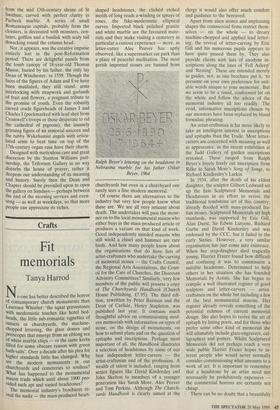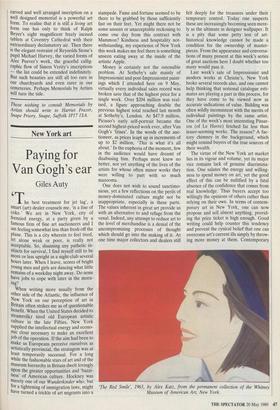Fit memorials
Tanya Harrod
o one has better described the horror of contemporary church monuments than Laurence Whistler: `the squat gravestones With modernistic touches like hotel bed- heads, the little sub-romantic vignettes of sunsets or churchyards, the machine- chopped lettering, the glass domes and periscopes that emerge from an oblong sea of white marble chips — or the same kerbs filled for some obscure reason with green bath-salts'. Over a decade after his plea for higher standards little has changed. Why are the modern monuments in our churchyards and cemeteries so soulless? What has happened to the monumental mason trade which until about 1900 pro- vided such apt and varied headstones? The memorial industry's brochures re- veal the nadir — the mass-produced heart- shaped headstones, the cliched etched motifs of long roads a-winding or sprays of roses, the fake-modernistic elliptical curves. Imported black polished granite and white marble are the favoured mate- rials and they make visiting a cemetery in particular a curious experience — more, as letter-cutter Alec Peever has aptly observed, like a supermarket car park than a place of peaceful meditation. The most garish imported stones are banned from Ralph Beyer's lettering on the headstone in Nebrasina marble for his father Oskar Beyer, 1964 churchyards but even in a churchyard one rarely sees a fine modern memorial.
Of course there are alternatives to the industry but very few people know what these are. We are all very reticent about death. The undertaker will pass the mour- ner on to the local monumental mason who either buys in the mass-produced article or produces a variant on that kind of work. Good independently minded masons who still wield a chisel and hammer are rare birds. And how many people know about the organisations that do have lists of artist-craftsmen who undertake the carving of memorial stones — the Crafts Council, the Regional Arts Associations, the Coun- cil for the Care of Churches, the Diocesan Advisory Committees? Similarly, very few members of the public will possess a copy of The Churchyards Handbook (Church House Publishing, £7.95). The third edi- tion, rewritten by Peter Burman and the Dean of Carlisle, Henry Stapleton, was published last year. It contains much thoughtful advice on commissioning mod- ern memorials with information on types of stone, on the design of monuments, on how to submit plans and on the question of epitaphs and inscriptions. Perhaps most important of all, the Handbook illustrates a selection of headstones by some of our best independent letter-carvers — the artist-craftsman end of the profession. A wealth of talent is included, ranging from senior figures like David Kindersley and John Skelton to members of a younger generation like Sarah More, Alec Peever and Tom Perkins. Although The Church- yards Handbook is clearly aimed at the clergy it would also offer much comfort and guidance to the bereaved.
Apart from alien stones and unpleasing shapes the commercial firms restrict them- selves — on the whole — to dreary machine-chopped and applied lead letter- ing; the revival of letter-carving by Eric Gill and his numerous pupils appears to have quite passed them by. They also provide clients with lists of anodyne in- scriptions along the lines of `Fell Asleep' and `Resting'. These are intended merely as guides, not, as one brochure put it, `to presume on your own preference for suit- able words unique to your memories'. But we seem to be a timid, conformist lot on the whole and follow the advice of the memorial industry all too readily. The vivid, informative inscriptions chosen by our ancestors have been replaced by bland formulaic phrasing.
An artist-craftsman is far more likely to take an intelligent interest in inscriptions and epitaphs than the Trade. Most letter- cutters are concerned with meaning as well as appearance, as the recent exhibition at the Judd Gallery of garden inscriptions revealed. These ranged from Ralph Beyer's lovely freely cut inscription from Rilke to Sarah More's Song of Songs, to Richard Kindersley's Larkin.
In 1934, after the death of his eldest daughter, the sculptor Gilbert Ledward set up the firm Sculptured Memorials and Headstones in an effort to revive the traditional tombstone art of this country, already flooded with mass-produced Ita- lian stones. Sculptured Memorials set high standards, was supported by Eric Gill, Alan Durst, Sir Edwin Lutyens, Richard Garbe and David Kindersley and was endorsed by the CCC, but it faded in the early Sixties. However, a very similar organisation has just come into existence. When her step-daughter died tragically young, Harriet Frazer found how difficult and confusing it was to commission a suitable headstone. Determined to help others in her situation she has founded Memorials by Artists. She has begun to compile a well illustrated register of good sculptors and letter-carvers — artist- craftsmen on the whole but including a few of the best monumental masons. Her register already reveals something of the potential richness of current memorial design. She also hopes to revive the art of epitaph by listing poets, and for those who prefer some other kind of memorial she will ultimately include glass-engravers, cal- ligraphers and potters. Whilst Sculptured Memorials did not perhaps reach a very wide public Harriet Frazer hopes to in- terest people who would never normally consider commissioning what amounts to a work of art. It is important to remember that a headstone by an artist need not necessarily be prohibitively expensive the commercial horrors are certainly not cheap.
There can be no doubt that a beautifully carved and well arranged inscription on a Well designed memorial is a powerful art form. To realise that it is still a living art form one has only to think of Ralph Beyer's eight magnificent freely incised tablets at Coventry Cathedral with their extraordinary declamatory air. Then there is the elegant restraint of Reynolds Stone's pupil Michael Harvey, the varied forms of Alec Peever's work, the graceful callig- raphic flow of Simon Verity's inscriptions — the list could be extended indefinitely. But such beauties are still all too rare in our churchyards and even rarer in our cemeteries. Perhaps Memorials by Artists will turn the tide.



































































 Previous page
Previous page